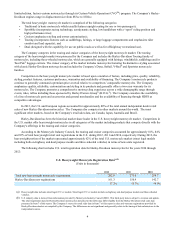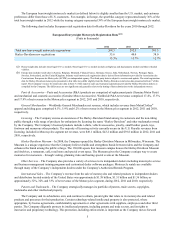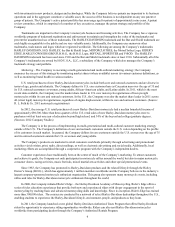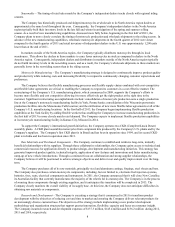Harley Davidson 2012 Annual Report Download - page 14
Download and view the complete annual report
Please find page 14 of the 2012 Harley Davidson annual report below. You can navigate through the pages in the report by either clicking on the pages listed below, or by using the keyword search tool below to find specific information within the annual report.14
Harley-Davidson branded motorcycles, those circumstances or any related decline in resale values for Harley-
Davidson-branded motorcycles could contribute to increased delinquencies and credit losses.
• The Company must effectively execute the Company’s restructuring plans within expected costs. During 2009,
2010 and 2011, the Company announced a combination of restructuring actions that are designed to reduce
administrative costs, eliminate excess capacity and exit non-core business operations. Effectively executing these
plans within expected costs and realizing expected benefits will depend upon a number of factors, including the time
required to complete planned actions and effective collaboration with the unions representing the Company’s
employees, the absence of material issues associated with workforce reductions, availability of and effective use of
third party service providers to assist in implementing the actions, avoidance of unexpected disruptions in production,
retention of key employees involved in implementing the restructuring plans and the ability of the Company to dispose
of vacated facilities in a cost effective manner.
• The Company has a number of competitors, some of which have greater financial resources than the Company.
Many of the Company’s competitors are more diversified than the Company, and they may compete in all segments of
the motorcycle market, other powersports markets and/or the automotive market. Also, the Company’s manufacturer’s
suggested retail price for its motorcycles is generally higher than its competitors, and if price becomes a more
important competitive factor for consumers in the heavyweight motorcycle market, the Company may be at a
competitive disadvantage. In addition, the Company’s financial services operations face competition from various
banks, insurance companies and other financial institutions that may have access to additional sources of capital at
more competitive rates and terms, particularly for borrowers in higher credit tiers. Failure to adequately address and
respond to these competitive pressures worldwide and in the U.S. may have a material adverse effect on the
Company’s business and results of operations.
• The Company’s marketing strategy of appealing to and growing sales to multi-generational and multi-cultural
customers worldwide may not continue to be successful. The Company has been successful in marketing its
products in large part by promoting the experience of motorcycling. To sustain and grow the business over the long-
term, the Company must continue to be successful selling products and promoting the experience of motorcycling to
both core customers and outreach customers such as women, young adults and ethnically diverse adults. The Company
must also execute its multi-generational and multi-cultural strategy without adversely impacting the strength of the
brand with core customers.
• The Company’s success depends upon the continued strength of the Harley-Davidson brand. The Company
believes that the Harley-Davidson brand has significantly contributed to the success of its business and that
maintaining and enhancing the brand is critical to expanding its customer base. Failure to protect the brand from
infringers or to grow the value of the Harley-Davidson brand may have a material adverse effect on the Company’s
business and results of operations.
• The Company is exposed to market risk from changes in foreign exchange rates, commodity prices and interest
rates. The Company sells its products internationally and in most markets those sales are made in the foreign
country’s local currency. Shifting foreign exchange rates can adversely affect the Company's revenue and margin, and
cause volatility in results of operations. The Company is also subject to risks associated with changes in prices of
commodities. Earnings from the Company’s financial services business are affected by changes in interest rates.
Although the Company uses derivative financial instruments to attempt to manage foreign currency exchange rates,
commodity price and interest rate risks, these instruments generally do not extend beyond one year and may expose
the Company to credit risk in the event of counterparty default to the derivative financial instruments. There can be no
assurance that in the future the Company will successfully manage these risks.
• The Company’s operations are dependent upon attracting and retaining skilled employees, including executive
officers and other senior leaders. The Company’s future success depends on its continuing ability to identify,
hire, develop, motivate, retain and promote skilled personnel for all areas of its organization. The Company’s
current and future total compensation arrangements, which include benefits and incentive awards, may not be
successful in attracting new employees and retaining and motivating the Company’s existing employees. In addition,
the Company must cultivate and sustain a work environment where employees are engaged and energized in their jobs
to maximize their performance. If the Company does not succeed in attracting new personnel, retaining existing
personnel, implementing effective succession plans and motivating and engaging personnel, including executive
officers, the Company may be unable to develop and distribute products and services and effectively execute its plans
and strategies.
























